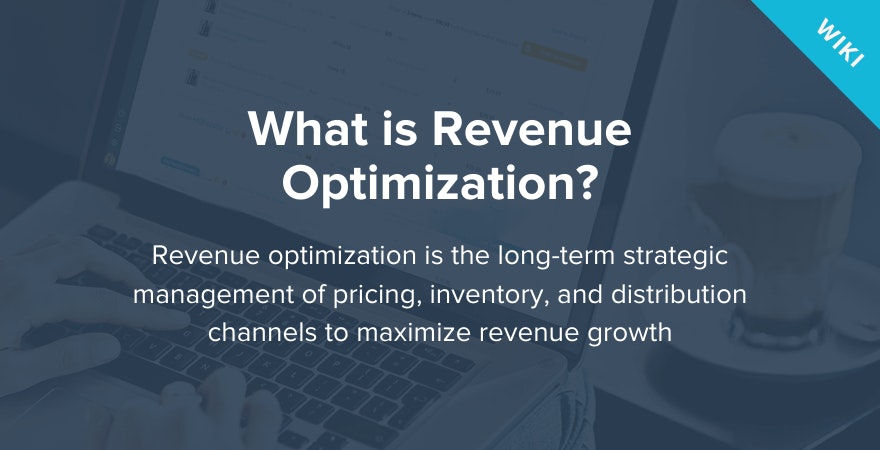
Revenue Optimization



What is Revenue Optimization?
Revenue optimization is the strategic management of pricing, inventory, demand and distribution channels to maximize revenue growth over the long term. It uses demand modeling, demand forecasting, pricing optimization, consumer behavior predictions, and other activities to ensure the right products are sold to the right customers at the right time and for the right price.
The Revenue Optimization Levers
eCommerce businesses striving to increase their revenue have a wide array of different strategies that can drive fast and profitable growth at their disposal. These can often be referred to as ‘levers’, in the sense that companies need to know which one to pull and when to pull it to dramatically increase their margins. The primary levers include:
- Pricing. When it comes to maximizing revenue, pricing optimization as one of the possible growth strategies often gets dismissed on the basis that online ecommerce businesses are always thinking to lower prices rather than raise them. It can be effective, but selling more products doesn’t always mean making more money. By adjusting your prices to target the higher-end customers, you not only avoid the customer service hassles that are linked with cheap offers but also significantly increase your margins. A successful pricing strategy is always backed by data and closely follows market conditions and demand in order to respond to changes quickly.
- Inventory. The simple truth is that the more inventory you have, the more variations you can offer, the more you can sell. This presents some serious challenges to online retailers who carry their own stock (e.g. warehousing costs if products don’t sell), yet drop shippers enjoy a massive advantage here due to their unique business model. When forming your inventory, it’s critical to let the data guide you. Items that sell quickly and have high margins should become your star products, around which all your campaigns and promotions are built. For example if, having analyzed the previous sales performance, you can identify a strong-selling item, then the next step would be to source a complimentary item and try to increase the average order value by bundling those two together. Cross-selling and upselling are also popular tactics used to generate more profit from the same customer.
- Marketing. To influence the success of their business, eCommerce store owners need to consider the most effective levers to pull. The essence of this practice is to discover tactics that have the biggest impact on sales and then amplify them. Driving relevant, quality traffic to your store and optimizing the conversion rate are two of the most important levers eCommerce entrepreneurs should focus on. However, the optimization process can be a laborious task, as there are many moving parts involved. For example, you have two ways to increase your traffic — you either buy it (AdWords, Facebook ads, Display ads, etc) or bait it (Content marketing, social media, SEO, etc). Now, both of these methods branch out into a number of different tactics that pose different challenges and can have varying degrees of impact on the bottom line. To find out what works best for your business at a given moment, you need to engage in testing and experimentation.
- Channels. eCommerce store owners often make a mistake of putting too much focus on one channel and completely disregarding the rest. The six different eCommerce channels that you need to keep in mind include: Direct traffic, Paid search, Comparison shopping engines (e.g. Google product search), Marketplaces (e.g. eBay or Amazon), Mobile, and Social media. The best way to approach channel optimization is to diversify and build a portfolio of eCommerce channels to minimize the risks that come with overdependence on one strategy.
The Revenue Optimization Process
The revenue management process can be broken down into 5 steps:
- Data collection. It all begins with delving knee-deep into data. To be able to predict consumer behavior, forecast trends and stay ahead of your competition, you need to collect as much historical data for inventory, demand, prices, and other factors as you can. Information that provides more details about the products offered, their prices, competitors, and customer behavior must be collected and analyzed to inform your decisions and dictate your strategy.
- Segmentation. When you pull all the data together and analyze it, you will be able to segment your customers into clusters based on their past purchases, interests, minimum spend, or any other factors that are important to your business. Market segmentation is essential in order to apply the right marketing tactics to the right customers.
- Forecasting. The natural next step is predicting future demand based on past performance. Forecasting helps companies allocate sufficient marketing budgets, plan for seasonal events or trends, ensure product availability and manage the inventory more efficiently. Combined with customer segmentation, forecasting helps eCommerce store owners pinpoint levers that can be optimized to achieve better profits.
- Optimization. Looking at your data analysis and forecasts, you can predict what your customers will do and how the market will behave at a certain point in time. With these unique insights at hand, you can determine what aspects of your business could be optimized to generate higher revenue, whether that’s changing your pricing strategy, increasing customer lifetime value, diversifying your marketing channels or expanding your product offerings. Implementing numerous optimization strategies at once can cause chaos and muddle your results, so go with the “less is more” philosophy.
- Dynamic re-evaluation. The market is constantly changing. What’s effective and yields brilliant results today, may be completely fruitless tomorrow, so make sure that you’re continually re-evaluating your products, pricing, and processes in order to maximize your revenue.



Want to Learn More?
- Pricing Strategy for eCommerce – Is Your Price Right?
- 25+ Best Price Comparison Websites and Apps You Need to Try
- Dropshipping Traffic Calculator
- What Should You Sell Online?
Is there anything else you’d like to know more about and wish was included in this article? Let us know!